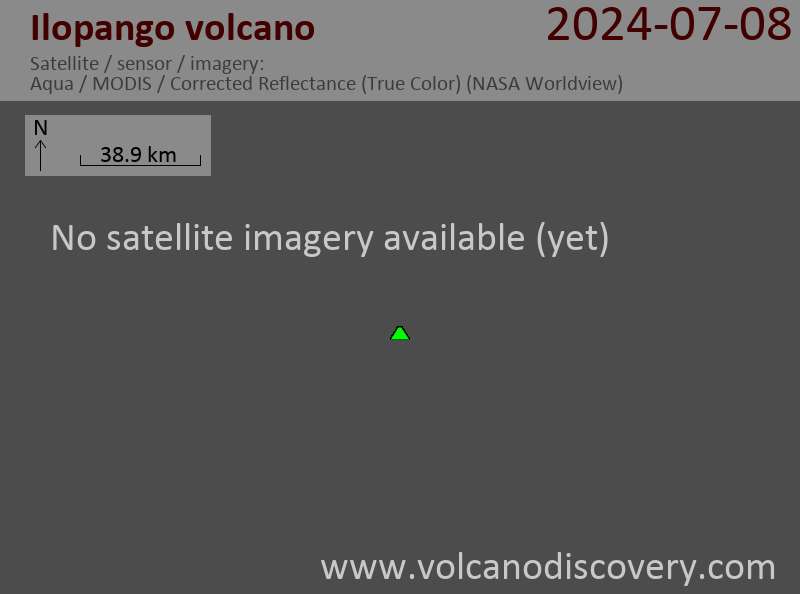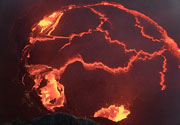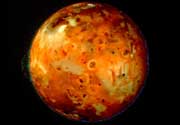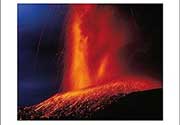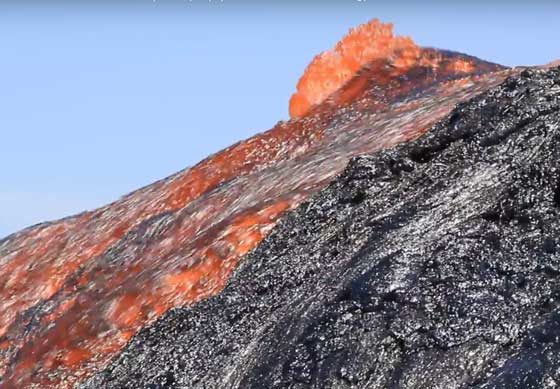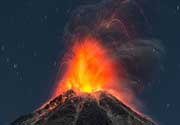Ilopango Volcano
Updated: Apr 23, 2024 06:33 GMT -
caldera 450 m / 1,476 ft
El Salvador, 13.67°N / -89.05°W
Current status: normal or dormant (1 out of 5)
El Salvador, 13.67°N / -89.05°W
Current status: normal or dormant (1 out of 5)
Ilopango volcano is a 8x11 km wide caldera at the eastern margin of San Salvador city, El Salvador. It is elongated to the east, has 150-500 m high walls and contains the scenic Lake Ilopango, one of El Salvador's largest.
The caldera is the result of at least 4 large plinian eruptions over the past few tens of thousands years. The lastest of these occurred in the 5th centruy AD. A historic eruption in 1879-80 formed Islas Quemadas ("burnt islands"), a group of islands in the center of the lake, corresponding to the summit of a mostly submerged post-caldera lava dome.
[smaller] [larger]
Ilopango volcano eruptions: 1879-80, 450 AD ±30 years
Latest nearby earthquakes
| Time | Mag. / Depth | Distance / Location | |||
| Apr 22, 01:56 am (El Salvador) | 2.5 175 km | 14 km (8.9 mi) to the SE | Info | ||
| Sunday, April 21, 2024 GMT (1 quake) | |||||
| Apr 20, 07:51 pm (El Salvador) | 3.0 5 km | 28 km (17 mi) to the S | Info | ||
Background
The caldera is controlled by regional faults of the central Salvador graben. 4 major dacitic-rhyolitic explosive eruptions during the late Pleistocene and Holocene produced extensive pyroclastic-flow and pyroclastic-fall deposits that blanket much of El Salvador. The latest collapse of Ilopango caldera resulted from the massive 5th century AD Terra Blanca Joven (TBJ) eruption, which produced widespread pyroclastic flows and devastated early Mayan cities. Post-caldera eruptions formed a series of glassy dacitic and andesitic lava domes within the lake and near its shore.Sources & further reading:
- Smithsonian / GVP Ilopango volcano information
- Golombek, M.P., and Carr, M.J. (1978) "Tidal triggering of seismic and volcanic phenomena during the 1879-1880 eruption of Islas Quemadas volcano in El Salvador, central America", Journal of Volcanology and Geothermal Research, v. 3, pp. 299-307
- Richer (2004) "Mafic magma injection triggers eruption at Ilopango Caldera, El Salvador, Central America", Geol. Soc. Special Paper, v 375, pp. 175-189
- Hart, W.J.E., and Steen-Mcintyre, V. (1983) "Tierra Blanca Joven tephra from the AD 260 eruption of Ilopango caldera", in: Sheets, P.D., ed. "Archeology and Volcanism in Central America", Austin, University of Texas Press, pp. 14-34
- Sheets, P.D. (1979) "Maya recovery from volcanic disasters, Ilopango and Ceren", Archaeology, v. 32, pp. 32-42
- Sheets, P.D. (1979) "Environmental and cultural effects of the Ilopango eruption in Central America", in: Sheets, P.D., ed. "Archeology and Volcanism in Central America", Austin, University of Texas Press, pp. 14-34
Eruptions of Ilopango volcano
1879-80 eruption
The last eruption of Ilopango constructed a new lava dome which emerged above the caldera lake and formed the Islas Quemadas, the "burnt islands".
It has been speculated that the eruption was affected by solid-earth tides, but a much more convincing and likely explanation was provided by Richer et al (2004) who demonstrate that an injection of 2% of basaltic-andesitic magma at the base of partially crystallized dacite magma triggered the 1880 eruption, creating the necessary overpressure needed for an eruption. ...more info
The last eruption of Ilopango constructed a new lava dome which emerged above the caldera lake and formed the Islas Quemadas, the "burnt islands".
It has been speculated that the eruption was affected by solid-earth tides, but a much more convincing and likely explanation was provided by Richer et al (2004) who demonstrate that an injection of 2% of basaltic-andesitic magma at the base of partially crystallized dacite magma triggered the 1880 eruption, creating the necessary overpressure needed for an eruption. ...more info
5th century eruption of Ilopango (around 450 AD)
A violent Plinian eruption occurred at Ilopango in the 5th century AD. It was the largest eruption in El Salvador during the past 10,000 years and one of the largest in Central America.
The eruption was larger than the Krakatau 1883 or Pinatubo in 1991, and probably more comparable to Tambora 1815. It ranks VEI 6-7. It erupted more than 70 cu km of tephra, produced major ash fall and large pyroclastic flows that covered 10,000 sq km under 50 cm or more of pumice and ash. Pyroclastic flows and ash fall devastated an area of up to 100 km radius around the volcano.
The eruption severely impacted the cultural history of the region: at the time, a sophisticated Mayan culture ruled and lived in the highlands of El Salvador. The eruption killed thousands, destroyed settlements and sent many to flee to the lowland areas in Guatemala and Belize. It ended the Mayan presence in the highlands, and it took probably several centuries for the region to recover.
A major trade route controlled by the Mayas was abandoned and power shifted to Tikal. Modern excavations of some of the buried settlements have been bringing light into Mayan culture.
A violent Plinian eruption occurred at Ilopango in the 5th century AD. It was the largest eruption in El Salvador during the past 10,000 years and one of the largest in Central America.
The eruption was larger than the Krakatau 1883 or Pinatubo in 1991, and probably more comparable to Tambora 1815. It ranks VEI 6-7. It erupted more than 70 cu km of tephra, produced major ash fall and large pyroclastic flows that covered 10,000 sq km under 50 cm or more of pumice and ash. Pyroclastic flows and ash fall devastated an area of up to 100 km radius around the volcano.
The eruption severely impacted the cultural history of the region: at the time, a sophisticated Mayan culture ruled and lived in the highlands of El Salvador. The eruption killed thousands, destroyed settlements and sent many to flee to the lowland areas in Guatemala and Belize. It ended the Mayan presence in the highlands, and it took probably several centuries for the region to recover.
A major trade route controlled by the Mayas was abandoned and power shifted to Tikal. Modern excavations of some of the buried settlements have been bringing light into Mayan culture.





